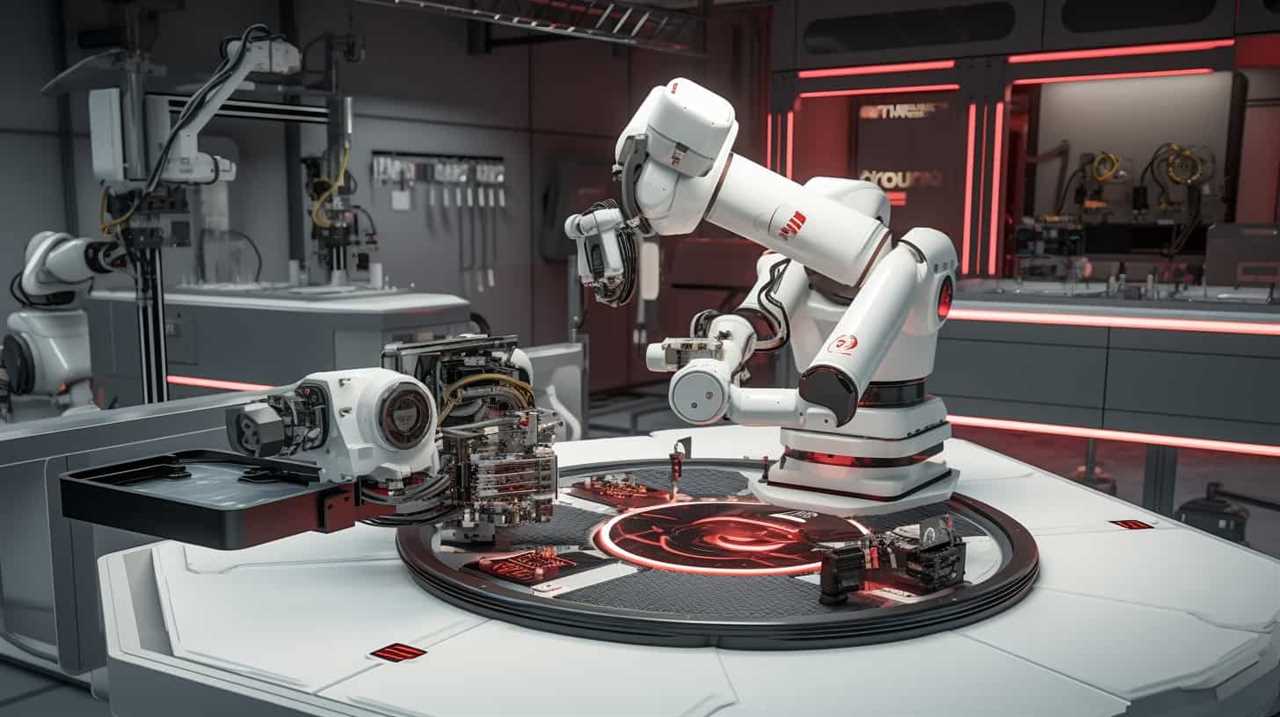We have all witnessed the remarkable advancements in artificial intelligence (AI) models. Yet, as progress continues, new challenges arise, particularly in dealing with adversarial attacks.
Our article delves into the strategies for mitigating these attacks, equipping you with the knowledge to safeguard your AI models.
From detecting vulnerabilities to implementing preventive measures, we explore the technical nuances and analytical approaches necessary for mastery in protecting AI models.
Join us as we navigate the intricate world of adversarial attack mitigation.

Key Takeaways
- Adversarial attacks pose significant risks to the reliability and trustworthiness of AI systems.
- Vulnerabilities in AI models, such as lack of robustness and susceptibility to adversarial examples, raise concerns about their reliability.
- Techniques such as adversarial sample detection, statistical analysis of input data, and model confidence analysis can help detect adversarial attacks.
- Strategies for adversarial attack prevention, including robust AI model development, input sanitization techniques, and regular model retraining, are crucial for ensuring the robustness and reliability of AI systems.
Types of Adversarial Attacks
In our exploration of adversarial attacks, we’ll delve into the various types of attacks that can target AI models.
One type of attack is known as transferability attacks. These attacks aim to take advantage of the vulnerability of AI models to adversarial examples that can be transferred from one model to another. By crafting a malicious input that fools one model, an attacker can exploit the similarity of AI models and trick other models into making incorrect predictions as well.
Another type of attack is physical attacks. These attacks involve manipulating the physical world to deceive AI models. For example, by adding imperceptible perturbations to stop signs, an attacker can trick an AI-powered autonomous vehicle into misclassifying the sign, posing a significant risk to safety.
Understanding these types of attacks is crucial in developing effective defense strategies to protect AI models.

Vulnerabilities in AI Models
To continue our exploration of adversarial attacks, let’s examine the vulnerabilities present in AI models.
AI models are susceptible to various vulnerabilities that can be exploited by adversaries to manipulate or deceive the system. One of the key vulnerabilities is the lack of robustness in AI models, which means they’re sensitive to small perturbations or changes in input data that can lead to misclassification or incorrect predictions.
Another vulnerability is the reliance on training data, as AI models can be fooled by carefully crafted adversarial examples that are designed to mislead the model into making wrong predictions.
These vulnerabilities have a significant impact on AI development, as they raise concerns about the reliability and trustworthiness of AI systems.

To address these vulnerabilities, potential solutions include developing more robust models that are resistant to adversarial attacks, incorporating adversarial training during model training, and implementing techniques like input sanitization and anomaly detection to detect and mitigate adversarial attacks.
Techniques to Detect Adversarial Attacks
We employ robust detection techniques to identify adversarial attacks on AI models. In order to effectively detect these attacks, we utilize advanced methods that can analyze the behavior and characteristics of the input data.
Here are four key techniques that we employ:
- Adversarial Sample Detection – We use algorithms to detect if a sample is adversarial by comparing it to known normal samples. This helps us identify any malicious inputs that might’ve been crafted to deceive the AI model.
- Statistical Analysis – By analyzing statistical properties of the input data, such as mean, variance, and distribution, we can detect any deviations that might indicate the presence of an adversarial attack.
- Model Confidence Analysis – We analyze the confidence scores produced by the AI model for different inputs. Adversarial attacks often lead to low confidence scores, as the model struggles to correctly classify the manipulated inputs.
- Input Tampering Detection – We examine the integrity of the input data, looking for any signs of tampering or modifications. Any discrepancies found can indicate the presence of an adversarial attack.
Strategies for Adversarial Attack Prevention
Building upon our robust detection techniques, our team implements proactive strategies to prevent adversarial attacks on AI models. Adversarial attack countermeasures are crucial in ensuring the robustness and reliability of AI systems.

One effective strategy is to focus on robust AI model development. This involves employing techniques such as adversarial training, where the model is trained on both clean and adversarial data to improve its resilience against attacks.
Additionally, we employ input sanitization techniques to filter out potential adversarial inputs. By carefully analyzing and preprocessing the input data, we can identify and discard malicious inputs before they reach the model.
Regular model retraining is also essential to ensure continued robustness against evolving attack methods.
Through these proactive strategies, we aim to build AI models that aren’t only accurate and efficient but also resilient to adversarial attacks.

Response and Recovery Plans
As part of our comprehensive approach to protecting AI models, we’ve developed response and recovery plans to swiftly address and mitigate the impact of adversarial attacks. These plans are crucial in minimizing the damage caused by such attacks and ensuring the resilience of our AI systems.
Here are the key elements of our incident management strategy:
- Rapid Detection: We’ve implemented advanced monitoring techniques to promptly identify any signs of adversarial attacks and trigger an immediate response.
- Containment and Mitigation: Once an attack is detected, our response team swiftly takes action to contain the impact and mitigate further damage by isolating affected systems and limiting the attacker’s access.
- Forensic Investigation: Post-attack analysis is conducted to understand the nature and extent of the attack. This helps us identify vulnerabilities and implement necessary measures to strengthen our defenses.
- Recovery and Adaptation: After addressing the immediate threats, we focus on restoring the affected AI models, ensuring their integrity, and adapting our defenses based on lessons learned from the incident.
Frequently Asked Questions
Can AI Models Be Protected From All Types of Adversarial Attacks?
We cannot fully protect AI models from all types of adversarial attacks. Robustness testing and countermeasures implementation are crucial, but adversaries constantly evolve their techniques, making it a continuous challenge to ensure complete security.
How Can Vulnerabilities in AI Models Be Identified and Addressed?
Identifying and addressing vulnerabilities in AI models is akin to inspecting a fortress for weak points and fortifying them. We employ techniques like robust training, adversarial training, and model monitoring to ensure the resilience of our models.

Are There Any Techniques to Detect Adversarial Attacks That Are Not Mentioned in the Article?
Detection techniques for adversarial attacks can be enhanced by employing novel approaches that go beyond those mentioned in the article. These innovative methods can provide an extra layer of security to AI models, ensuring better protection against potential malicious attacks.
Besides Prevention, Are There Any Strategies for Mitigating the Impact of Successful Adversarial Attacks?
When it comes to protecting AI models, we must not only focus on prevention but also on strategies for impact mitigation and post-attack recovery. This ensures that we can effectively respond to successful adversarial attacks.
What Are Some Common Challenges Faced During the Response and Recovery Phase After an Adversarial Attack?
Response and recovery challenges after an adversarial attack include identifying the extent of the breach, restoring compromised systems, and mitigating further damage. The incident response process is crucial for timely detection and effective resolution.
Conclusion
In conclusion, protecting AI models from adversarial attacks requires a multi-faceted approach. By understanding the types of attacks and vulnerabilities, implementing techniques to detect attacks, and employing strategies for prevention, organizations can enhance the security of their AI systems.

Just as a fortress relies on multiple layers of defense mechanisms to keep intruders at bay, safeguarding AI models requires a thorough and comprehensive defense strategy.
Only by being vigilant and proactive can we ensure the integrity and reliability of AI technologies.
Bennett is the embodiment of versatility, adapting his writing to cover a broad spectrum of topics with professionalism and flair. Whether it’s breaking news, in-depth analyses, or feature pieces, Bennett’s contributions enrich Press Report with diverse perspectives and engaging content. His adaptability and keen journalistic instincts make him a vital member of our team, capable of capturing the essence of the moment in every story.










